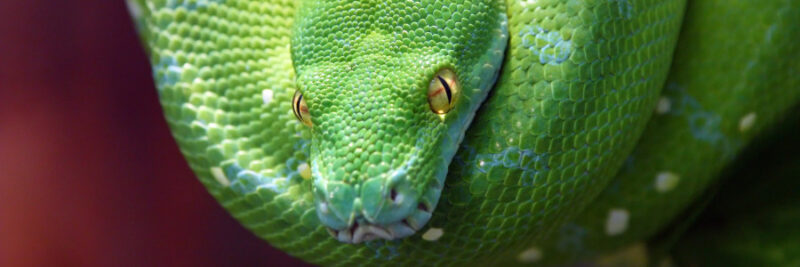The green tree python is a gorgeous arboreal snake species found in tropical regions of Australia, New Guinea, and nearby islands. With its vivid green colors, slender body, and habit of draping itself along rainforest branches, it’s a visually impressive reptile both in the wild and in captivity.
Appearance and Description

These snakes are named for their typically bright green coloration as adults, ranging from shades of mossy mint to almost turquoise-tinged lime green. Juveniles often hatch with shades of red, yellow, or blue and transition to the iconic green as they mature over 12-18 months.
Green tree pythons have a distinct slender, arboreal build with tails nearly as long as the rest of their bodies. Adults reach 4-6 feet in total length. Diamond-shaped heads with heat-sensing pits along the lips help them hunt warm-blooded prey while their prehensile tails aid in wrapping around branches. Their scales have irregular, angular patterns compared to other pythons.
Native Habitat and Behavior

These pythons live in tropical lowland rainforests and woodlands, spending nearly their entire lives up in trees. Native habitats have warm, humid year-round temperatures with high rainfall.
Their arboreal nature means they move slowly and deliberately through the canopy, suspension themselves from branches with their prehensile tails to ambush passing prey. They remain coiled or draped over branches waiting for unsuspecting birds, bats, or arboreal mammals to wander within strike range.
Though not venomous, they are constrictors and will quickly wrap their bodies around prey once struck, squeezing tightly to suffocate victims. This allows them to consume larger prey relative to their slender builds.
Breeding and Reproduction
Green tree pythons typically breed between October and January in their native range. Females produce clutches of 10-20 eggs approximately two months after mating, tending them until they hatch after two more months of incubation.
Hatchlings average 16-22 inches in length and spend the first few weeks of life in trees and shrubs below the main canopy. Juvenile mortality rates are high in the wild. Those surviving to adulthood face potential predation by birds of prey and other snakes in their arboreal habitats.
Captive specimens have been documented to live over 20 years with proper husbandry, compared to 10-15 years typical in their native environments.
Care in Captivity

Caring for green tree pythons as pets requires committing to specialized husbandry meeting their arboreal, tropical needs:
Enclosures
– tall, narrow screen or glass enclosures minimum 4 feet tall by 2 feet wide are best to allow climbing and provide adequate ventilation.
Heating & Light
– ambient and basking temperatures of 85-90°F during daytime hours, dropping to 75-80°F overnight are needed. Thermostats prevent overheating. UVA/UVB lighting on 12-14 hour cycles mimics natural photoperiods.
Humidity
– given their rainforest origins, humidity levels of at least 65-80% must be maintained. This is aided with large water bowls, misters, and damp substrates like sphagnum moss or coconut husks.
Feeding
– juvenile green tree pythons should be fed once every 5-7 days while adult specimens do well with weekly prey items. Food items at appropriate sizes can include rodents such as rats or mice as well as small birds.
While their specialized needs make them challenging for beginner reptile owners, green tree pythons are one of the most stunning and fascinating display snakes for the intermediate or advanced hobbyist committed to providing an arboreal, rainforest-like environment. When properly cared for, these amazing apex ambush predators of the canopy can thrive in captivity.
Frequently Asked Questions About Green Tree Pythons
Green tree pythons live in warm, humid lowland tropical rainforests and adjacent woodlands of northern Australia, New Guinea, and nearby islands. They spend nearly all their time up in trees and shrubs.
No, green tree pythons are nonvenomous constrictors that subdue prey by coiling their slender bodies around victims and squeezing tightly to suffocate them. They then swallow prey whole
Hatchlings exhibit bright red, yellow, or blue colors before transitioning to the iconic green shades as adults. Their heat-sensing lip pits allow them to precisely strike warm-blooded prey even in darkness.
Slender green snakes 4-6 feet long with tails nearly as long as the body and heads distinctively wide and diamond-shaped. Heat-sensing pits line the lips. Highly arboreal build with prehensile tails to grip branches.
In summary, the green tree python is an arboreal rainforest snake with several key adaptations aiding its tree-dwelling ambush predator lifestyle. Their unique appearance and behaviors make them fascinating captives for experienced reptile enthusiasts able to meet their specialized care needs. With proper enclosures and husbandry replicating tropical treetop habitats, they can thrive in private collections.

